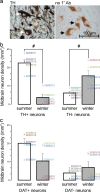Differences in Number of Midbrain Dopamine Neurons Associated with Summer and Winter Photoperiods in Humans
- PMID: 27428306
- PMCID: PMC4948786
- DOI: 10.1371/journal.pone.0158847
Differences in Number of Midbrain Dopamine Neurons Associated with Summer and Winter Photoperiods in Humans
Abstract
Recent evidence indicates the number of dopaminergic neurons in the adult rodent hypothalamus and midbrain is regulated by environmental cues, including photoperiod, and that this occurs via up- or down-regulation of expression of genes and proteins that are important for dopamine (DA) synthesis in extant neurons ('DA neurotransmitter switching'). If the same occurs in humans, it may have implications for neurological symptoms associated with DA imbalances. Here we tested whether there are differences in the number of tyrosine hydroxylase (TH, the rate-limiting enzyme in DA synthesis) and DA transporter (DAT) immunoreactive neurons in the midbrain of people who died in summer (long-day photoperiod, n = 5) versus winter (short-day photoperiod, n = 5). TH and DAT immunoreactivity in neurons and their processes was qualitatively higher in summer compared with winter. The density of TH immunopositive (TH+) neurons was significantly (~6-fold) higher whereas the density of TH immunonegative (TH-) neurons was significantly (~2.5-fold) lower in summer compared with winter. The density of total neurons (TH+ and TH- combined) was not different. The density of DAT+ neurons was ~2-fold higher whereas the density of DAT- neurons was ~2-fold lower in summer compared with winter, although these differences were not statistically significant. In contrast, midbrain nuclear volume, the density of supposed glia (small TH- cells), and the amount of TUNEL staining were the same in summer compared with winter. This study provides the first evidence of an association between environmental stimuli (photoperiod) and the number of midbrain DA neurons in humans, and suggests DA neurotransmitter switching underlies this association.
Conflict of interest statement
Figures



References
MeSH terms
Substances
LinkOut - more resources
Full Text Sources
Other Literature Sources

